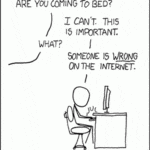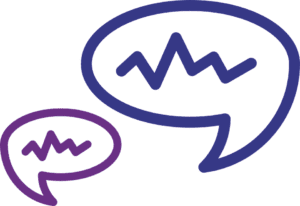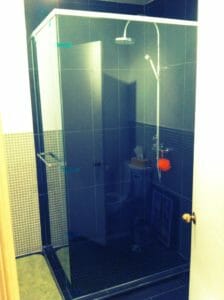Sleep, The Final Frontier

I spent the better part of twenty years getting to the place where I sleep well most nights. It’s time to share.
History:
Modern life disrupts natural sleep. Humans evolved to respond to changes in light and temperature by sleeping in different cycles in the summer or winter. We are wired to sleep more when it is dark and cold. There is evidence that “normal” sleep consisted of two periods of sleep, not one eight-hour block. Adults woke in the middle of the night for some period of time after their “first sleep”. Now, when we wake in the middle of the night, it is called insomnia.
Nights were dark inside and out until the last few hundred years. Sure, there were candles and lamps, but fuel was costly and fire was a danger. Indoor lights went out at bedtime. Cities were darker at night, before street lighting began in Paris in 1667. Then other cities lit their streets, but roads outside the city remained dark until electric lighting became available. Before central heating, fires and stoves went out in the wee hours of the night. Houses were cold by dawn. People slept under more covers than we need now. We don’t live like that anymore, so how do we sleep enough to be healthy and clearheaded?
How to use this advice: I am about to give advice based on what I have tried in my quest of good-enough sleep. Every neurology is different, so my results will not be yours. The best way to figure out what works is to change one thing at a time. Try it for a week or two or more, then add something else. Try the thing you suspect might make the biggest difference. If that works, then add other things that are similar.
Paying attention to the environment.
Light and Darkness
Your nervous system responds to light and darkness, whether you are aware of it or not. There is light all around us, all the time, so our nervous system doesn’t get the message that it is time to slow down and go to sleep. Depending on how sensitive to light issues you are, notice these things, and rule them out.
 Need for light: Daylight is restorative and helps with sleep. Get some exposure to natural light every day. Consider consciously adding a short walk outside, every day. I read someplace that six minutes is enough.
Need for light: Daylight is restorative and helps with sleep. Get some exposure to natural light every day. Consider consciously adding a short walk outside, every day. I read someplace that six minutes is enough.
Need for darkness: Urban and suburban residents are exposed to light all day and all night. If you don’t believe me, turn off your bedroom light and look at the “dark” coming in through the window.
Outdoors:
Streetlights add to safety while walking, biking or driving at night. Avoid looking directly into lights. Try yellow or orange tinted glasses to reduce the amount of white light exposure at night.
Indoors:
 Limit the light that comes into the windows of your bedroom. Consider adding room darkening shades (like the ones you see in hotels). They make your bedroom fully dark. That tells your brain that it is nighttime. It also keeps early dawn from waking you.
Limit the light that comes into the windows of your bedroom. Consider adding room darkening shades (like the ones you see in hotels). They make your bedroom fully dark. That tells your brain that it is nighttime. It also keeps early dawn from waking you.
Start turning down the house lighting a few hours before bedtime. Whole rooms do not need to be bright unless you are entertaining. Use direct lighting if you are sewing or reading or doing something with small things, that need light so you can see them.
If you read before sleep, use a single light to illuminate your book. If you use an electronic reader, turn on the night settings and turn down the light as much as you can without causing eye strain. If you read on screens in the evening (who doesn’t?), set all screens to night mode and turn down the light setting as much as possible.
 Turn off all screens two hours before bedtime. Do an experiment for two weeks! No social media, on-line or electronic reading, or television programs. Instead, listen to music, or cook something, or talk to someone, or read a paper book or magazine. This will do a number of things for you. First, it tells your neurology that it is night. Second it limits your exposure to information that excites your brain, for good or for bad. How do people who watch TV news (even The Daily Show) just before bedtime ever fall asleep and sleep well? The same thing is true of people who can’t sleep because someone on the internet is wrong.
Turn off all screens two hours before bedtime. Do an experiment for two weeks! No social media, on-line or electronic reading, or television programs. Instead, listen to music, or cook something, or talk to someone, or read a paper book or magazine. This will do a number of things for you. First, it tells your neurology that it is night. Second it limits your exposure to information that excites your brain, for good or for bad. How do people who watch TV news (even The Daily Show) just before bedtime ever fall asleep and sleep well? The same thing is true of people who can’t sleep because someone on the internet is wrong.
Nightlights are for safety only. Unless you are accommodating guests who don’t know your house, you probably don’t need nightlights. If you open the curtains in the bathroom, street lighting is enough for most people to safely get around.
Temperature
Our brains think cooler means sleep time, until about 54 degrees. Since central heating is available, keep your house toasty warm through dinner, but let it cool down to about 60 degrees during sleep hours.
Melatonin (a chemical that aid sleep) is released, naturally, when the room is 60-67 degrees. Let your bedroom temperature stay in that range. Most people can’t sleep if they feel too cold. Let the air in your bedroom be cooler, and you can be under a blankets, with flannel sheets or plush pajamas, and you’ll still get the same affect. Some sources recommend turning the air conditioning to that cool in the summer, too. That’s not for me, but your mileage may vary.
Another easy hack if you can’t sleep is to do this: Once you get warm and comfortable in bed, stick your feet, or one leg, out from under the covers. That causes a drop in your body temperature and tells your brain it’s time to sleep. This works for me in the middle of the night. It doesn’t work as well if my feet haven’t warmed up under the blankets first.
Now that we have the house ready for you to sleep in, what about the people you live with, and the noise in your own head and body?
Quiet Maybe quiet is the final frontier, not sleep.
External noise: People and other noisemakers.
 If you live with people, they are going to wake you up, sometimes. Talk to them about ways they can limit those occurrences. Ask everyone to commit to supporting your need to sleep, as best the person can; obviously, babies will be babies, but even three or four year olds can learn to be part of the solution. Example: “When you come in to sleep with Mommy, don’t turn the light on and off to tell me you’re here. Just crawl in.”
If you live with people, they are going to wake you up, sometimes. Talk to them about ways they can limit those occurrences. Ask everyone to commit to supporting your need to sleep, as best the person can; obviously, babies will be babies, but even three or four year olds can learn to be part of the solution. Example: “When you come in to sleep with Mommy, don’t turn the light on and off to tell me you’re here. Just crawl in.”
Your bedroom should be a place where you sleep and have sex. All other activities are optional. Anything that engages you in the business of the day does not belong there. Phones and electronics belong out of the bedroom; they are things of an active mind, not of a restful mind. Reading a thriller in bed can lead to reading into the wee hours, and is therefore not recommended.
If there is no one you need to answer the phone about in the middle of the night, remove phones from the bedroom. Watch TV or video someplace else. Remove pictures of anyone but yourself and your partner. This is your safe space.
Some people like white noise machines to block out street or building noises.
Internal noise: Maybe this is really the final frontier.
I am not going to go all guru on you. I promise. Here are some simple things that even the most Type A, Western, mind-over-matter sorts can do:
Positive statements: Telling yourself something that is true and settling. Example:
“I could have leukemia!” versus “I will know how serious this is when the blood tests come back.” The goal is to stick with the known facts and tell yourself to stop guessing at all the terrible things that have not happened and might not happen.
This how it works:
- “I could have leukemia!” “I will know how serious this is when the blood tests come back.”
- “I could have leukemia!” “I will know how serious this is when the blood tests come back.”
- “BUT, I could have leukemia!” “I will know how serious this is when the blood tests come back.” “I could also have a really bad flu. I will know when I get the blood tests back” (Notice that I am no longer saying “serious”)
- “I could have mono and lose a month of work!” “I will know that when I get the blood tests back”
- “When will they come back?” “Tomorrow or the next day”…. “
- “I can’t wait, what if I have leukemia?” “I will know that when I get the blood tests back”
- “But, what if?” “I will know that when I get the blood tests back. If something is wrong, the doctor will know more than I can guess at in the middle of the night”
- “But, what if?” “The doctor will tell me and I’ll check it out”
- “But, what if?” “There’s no doctor in this bed, go to sleep! I will know that when I get the blood tests back”
 If this kind of internal “conversation” goes on for more than 15-20 minutes, get out of bed. Go to a dimly lighted room. If you are vaguely hungry, eat something that is slightly starchy or protein with some fat (examples: a bowl of cold cereal with milk or yogurt or toast and warm milk). If you have muscle tension, have a warm shower. If you feel good, but have a racing mind, distract your mind with something neutral, but engaging (examples: word search puzzles, Sudoku, crossword puzzles, reading an engaging book or magazine article, listening to music with a headphone). When you perceive that you are tired, go back to bed.
If this kind of internal “conversation” goes on for more than 15-20 minutes, get out of bed. Go to a dimly lighted room. If you are vaguely hungry, eat something that is slightly starchy or protein with some fat (examples: a bowl of cold cereal with milk or yogurt or toast and warm milk). If you have muscle tension, have a warm shower. If you feel good, but have a racing mind, distract your mind with something neutral, but engaging (examples: word search puzzles, Sudoku, crossword puzzles, reading an engaging book or magazine article, listening to music with a headphone). When you perceive that you are tired, go back to bed.
Other examples:
To-do lists: “I scheduled to pack between 8-10 tomorrow night” versus “I have to pack my bags! What should I bring?” The trick to letting go of to-do lists is to remind yourself that you set time aside the next day to make the decisions. If you start packing in your head, you can spend hours deciding what shirt to wear, so don’t start packing in your head.
Conflicts: “This relationship will go on (or not). My goal is to establish that I will do X, but not Y, in the future” verses “I have to deal with that !%@#%@#! I should have said ____! If she says ____ I’ll say %&*(%&!” The positive thought is to commit to your goals. Repeat them to yourself, so that you are prepared to get your needs met. If you start having hypothetical conversations, you can spend hours creating an argument that probably has no similarity to the argument you will have, when you actually talk to the person.
Daily practices that help sleep:
Daytime stress reduction: There are millions of pages written about how to keep your mind clear. Having a routine for clearing the mind helps sleep, too.
Exercise: Some people sleep better if they exercise first thing in the morning; some do better exercising at the end of the day. This is another place where experimenting will help. Make one change and stick with it for a month before judging how it affects your sleep.
Meditation or meditative practice: Try one of the many, many apps on the phone to regulate your breathing and get you meditating. My favorite is Breathe+. Another popular one is Calm. Give it five minutes a day for a month. If you like it, go up to twenty minutes once or twice a day. Remember to set all your devices to switch to night settings.
Some people can’t do a sitting meditation, because being in quiet makes them anxious. If you are like that, start with something that requires movement, like Tai Chi, or Qi Gong, or yoga. You can get access to these practices by video, so they are available to try on the cheap. Then, get better guidance for something that clicks for you.
You won’t feel a difference for at least a month, and maybe more. Stick with a practice for a whole season before judging if it affects you sleep.
Feel good to sleep well
Here are some general pointers on nutrition and pain management. Many of us need professional care from a doctor or other practitioner to address specific nutritional needs and our own particular physical pain.
Nutrition: This is true for many people, but your mileage may vary.
Personally, I don’t sleep well unless I ate a full dinner within about five hours of bedtime. A heavy lunch with a light dinner doesn’t do it for me.
I drink clear fluids with dinner and until about two hours before bed, then stop. I generally don’t eat after dinner, but if I do, I avoid white sugars, chocolate, or caffeine.
Pain management: Pain and tension are personal. Serious pain needs medical/professional care. Daily tension can be made better with one or more of these:
- Heat: By the end of the day, most people have tense muscles. A nightly hot shower or going to bed with a heated pad will reduce the tension most of us have in our upper backs and necks.
- Cold: If you have muscle pain, you may have swelling. Twenty minutes of resting on ice reduces swelling. However, if you are then going to sleep, apply heat after icing. It will not undo the benefit from the ice.
Here’s a link about how to make your own hot or cold packs. You can also purchase these items.
- Stretching: Stretching regularly reduces pain from normal wear and tear on your soft tissues. Locate a set of stretches that address the places where you hold tension all day. You can find them online. They can be from yoga practice or from physical therapy. You can strengthen your neck in a few minutes a day, too. You only need three to five of them and they will only take five minutes to do.
Get in the habit of stretching every day at the same point in the day. That may be when you get home from work, before dinner, after dinner, when you stop using the computer or television for the night, as soon as the kids are in bed, or whatever is a point where you want to signal your body that busy time is over.
Good luck and good night!